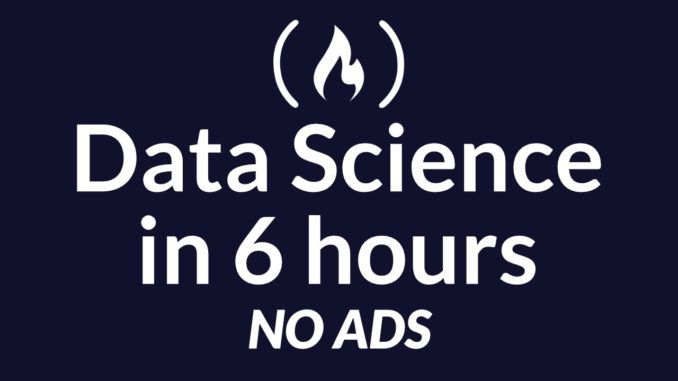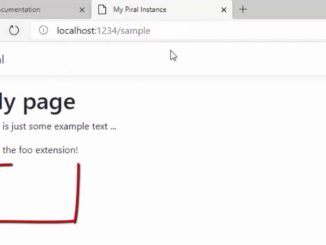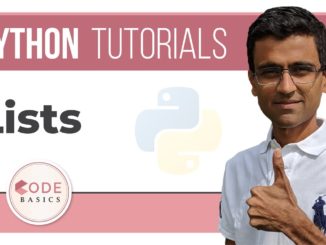
Learn Data Science is this full tutorial course for absolute beginners. Data science is considered the “sexiest job of the 21st century.” You’ll learn the important elements of data science. You’ll be introduced to the principles, practices, and tools that make data science the powerful medium for critical insight in business and research. You’ll have a solid foundation for future learning and applications in your work. With data science, you can do what you want to do, and do it better. This course covers the foundations of data science, data sourcing, coding, mathematics, and statistics.
? Course created by Barton Poulson from datalab.cc.
? Check out the datalab.cc YouTube channel: https://www.youtube.com/user/datalabcc
? Watch more free data science courses at http://datalab.cc/
⭐️ Course Contents ⭐️
⌨️ Part 1: Data Science: An Introduction: Foundations of Data Science
– Welcome (1.1)
– Demand for Data Science (2.1)
– The Data Science Venn Diagram (2.2)
– The Data Science Pathway (2.3)
– Roles in Data Science (2.4)
– Teams in Data Science (2.5)
– Big Data (3.1)
– Coding (3.2)
– Statistics (3.3)
– Business Intelligence (3.4)
– Do No Harm (4.1)
– Methods Overview (5.1)
– Sourcing Overview (5.2)
– Coding Overview (5.3)
– Math Overview (5.4)
– Statistics Overview (5.5)
– Machine Learning Overview (5.6)
– Interpretability (6.1)
– Actionable Insights (6.2)
– Presentation Graphics (6.3)
– Reproducible Research (6.4)
– Next Steps (7.1)
⌨️ Part 2: Data Sourcing: Foundations of Data Science (1:39:46)
– Welcome (1.1)
– Metrics (2.1)
– Accuracy (2.2)
– Social Context of Measurement (2.3)
– Existing Data (3.1)
– APIs (3.2)
– Scraping (3.3)
– New Data (4.1)
– Interviews (4.2)
– Surveys (4.3)
– Card Sorting (4.4)
– Lab Experiments (4.5)
– A/B Testing (4.6)
– Next Steps (5.1)
⌨️ Part 3: Coding (2:32:42)
– Welcome (1.1)
– Spreadsheets (2.1)
– Tableau Public (2.2)
– SPSS (2.3)
– JASP (2.4)
– Other Software (2.5)
– HTML (3.1)
– XML (3.2)
– JSON (3.3)
– R (4.1)
– Python (4.2)
– SQL (4.3)
– C, C++, & Java (4.4)
– Bash (4.5)
– Regex (5.1)
– Next Steps (6.1)
⌨️ Part 4: Mathematics (4:01:09)
– Welcome (1.1)
– Elementary Algebra (2.1)
– Linear Algebra (2.2)
– Systems of Linear Equations (2.3)
– Calculus (2.4)
– Calculus & Optimization (2.5)
– Big O (3.1)
– Probability (3.2)
⌨️ Part 5: Statistics (4:44:03)
– Welcome (1.1)
– Exploration Overview (2.1)
– Exploratory Graphics (2.2)
– Exploratory Statistics (2.3)
– Descriptive Statistics (2.4)
– Inferential Statistics (3.1)
– Hypothesis Testing (3.2)
– Estimation (3.3)
– Estimators (4.1)
– Measures of Fit (4.2)
– Feature Selection (4.3)
– Problems in Modeling (4.4)
– Model Validation (4.5)
– DIY (4.6)
– Next Step (5.1)
—
Learn to code for free and get a developer job: https://www.freecodecamp.org
Read hundreds of articles on programming: https://www.freecodecamp.org/news
And subscribe for new videos on technology every day: https://youtube.com/subscription_center?add_user=freecodecamp
source




34:00 excel is misunderstood, there are a lotof things you can do with excel
One day we will get to the coding, one day
Where are we downloading the files you talking about at 2:47:00 from kindly?
Thank you!
please I'm studying mathematics in the university but I wont to become a data sciencist , where do i start from?
26:29 No , no. Abilities don't work that way!
Is that the reason your voice is 'sexy'?
Hello! I just finished the whole video and would like to say thanks! I hope this starts out my journey in learning more about data science. This provided a wide overview of the concepts, tools, and thinking that will be needed in DS. Without being daunting and yet not mind-numbingly dumbed down. Again, thank you!
Sorry But I couldn't find this file: DS03_2_1_Spreadsheets.xlsx
very good one- Thanks you
Hi there, Do you know if there is a way to download all the notes or pdfs for this video tutorial? Please advice. Thank you !
Great content! He's like the Mister Rogers of Data Science.
Hello comunity , can you recommend some full course to learn R
Done! Thanks for the great overview! This would help me tremendously on my to become a Data Scientist!
an hour feels like minutes passed, its so buttery structured and explained. Lots Of Love
Thanks for your video report and education!
My basic is statistics, I don't even know about coding. So, here I am.
1:54:59
I will become a unicorn!
Does anyone if know if the data science in codacademy is useful for beginners?
Easy to understand
@48:00
Hold up.
Numbers don't lie. If there is a statistic that is politically incorrect but factual, so be it. Computers have no biases, therefore it is hypocritical to change the statistical outcome of the project.
Let's say we do research on crimes committed by certain demographics or people groups, and it shows a disproportionate amount being committed by one group. Are you saying we should change the result to make that group not look so bad? Or should we leave it and let the numbers speak for themselves? This is concerning, because it doesn't sound like discretion. It sounds like lies to me.
8:41 diagram venn
15:08 DS pathway
19:40 role of DS
23:41 team in data science
48:37 Method
1:02:22 statistic method
1:06:20 ML method
1:09:00 communicatting (interpretability etc..)
I’m a financial analyst right now but I already know SQL and Power BI. I’d like to learn Python and R so I can move to a role where I can combine my existing finance knowledge with data science
Nice video sir
I prefer the hands-on videos, how am I actually going to learn just by listening to a huge amount of information?
Definitely the most useful video on the topic! Many thanks to the author!
15000th like
Thanks for the great video.
Is there possible to get the material for this course? It would be nice for me.
Is this is enough for data science?
it's weird how you speak exactly like salman khan from khan academy.
Quincy if u are reading this……We all campers really appreciate from bottom of our heart for whatever u r doing for us. I just want to say that nobody gives a damn if u start putting ads in between the videos. I have an ad blocker but for the sake of this channel I'll disable it, as that's the only way I can contribute right now and there are many more like me. Start putting ads.
Thanks to Free code Camp.
this course is purely introductory.
Sadly the people I worked for didn't give 2 fucks about privacy. To them, everything is legal if it can make them richer. I gave up and resigned.
Simple and elegant explanation of probability. Thanks!
waw v best
17:20
I'm an hour in and:
1) You haven't really said anything.
2) You just said you don't really need to know math to do any data science.
#2 is just patently false, man. I get that you probably just made this for clicks, but… really?
This is a great video! Very well explained concepts. As an established data scientist myself, it helps to have resources like these to brush up on my fundamentals. I also have a few videos on my channel that talk more about the experience working as a data scientist for those that are interested!
Where can I find the downloadable files for this course?
How is seeing this in 2020 subscriber vlog with prithvi
12:30
For the one who did the subtitles, god bless you
Predjudices in data?! Does it mean to politically review it, or withhold the information that the data provide?
Just started this and what an insightful video so far for newbies like me. Thank you for this and looking forward to watching more of your videos! Thank you!
Is this a good place to start for someone who doesn't know how to code?
Really good course but I'm not okay with the example at 26:00 , so basically you can get a thousand people who knows hello world and put them in a team does this makes anything better?
I'm not gonna lie, there is no chance I'm going to watch all of this, but from what I've seen so far, this is an AMAZING beginners guide to understand every facet of data science. Thanks for this awesome resource. I'm excited to see more resources popping up showcasing more projects and real world experience beginners can learn from